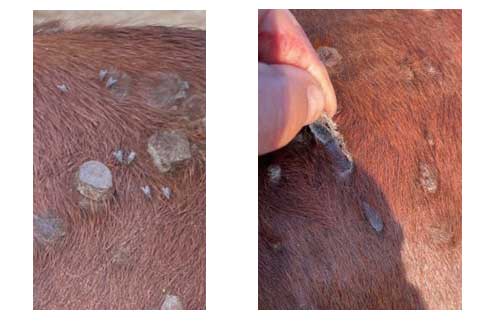Heifer with ‘lumpy’ skin lesions – LSD rule-out
Unusual presentation:
Investigation of skin lesions in response to industry alert for increased vigilance around Lumpy Skin Disease.

Above: Thick encrustations of matted hair and dried exudate that peeled off leaving bare areas of normal skin.
Time and location: June 2022, WA.
Case definition: Lumpy skin lesions consisting of very thick encrustations of matted hair and dried exudates that can be peeled off leaving bare areas of normal skin with signs of some new hair follicles just starting to emerge.
Disease mapping: A Brahman-cross heifer from a large mob was the only animal presenting with lesions.
Gross findings: The heifer was bright and alert, and did not show any signs of fever, lethargy, reluctance to move or inappetence.
The differential diagnosis list prior to the visit included dermatophilosis, ringworm, warts (Papillomatosis virus), and LSD – which was important to rule out, although considered unlikely given the absence of clinical illness and only a single animal.
The field diagnosis, following clinical examination, was most consistent with Dermatophilosis. A biopsy was taken of one lesion and a portion fixed in 10% Formalin, another in Viral Transport Medium and another fresh sample. Samples of the matted hair crustations were collected. Blood samples (Plain and ETDA) were collected from this heifer and another 9 cohorts.
Laboratory findings: Histopathology identified intra-lesional organisms and changes consistent with Dermatophilus congolensis infection. Bacteriology isolated a moderate growth of the organism as well as Trueperella pyogenes.
Samples were sent to CSIRO Australian Centre for Disease Preparedness (AAHL/ACDP). No virus particles were observed on electron microscopy and capripoxvirus and pan-parapoxvirus PCRs (from EDTA bloods, fresh biopsy, fresh scab, and biopsy swab in VTM) proved negative; capripox antibody ELISAs were also negative. Lumpy skin disease (LSD) was ruled out.
Conclusions: This was a confirmed to be Dermatophilus and Lumpy Skin Disease was ruled out. Though this was a false alarm in regards to an EAD, it is a good example of a producer reporting an unusual presentation. The full work up of the case reinforces to the producer that we take such reports seriously and encourages them to continue to report unusual cases.
